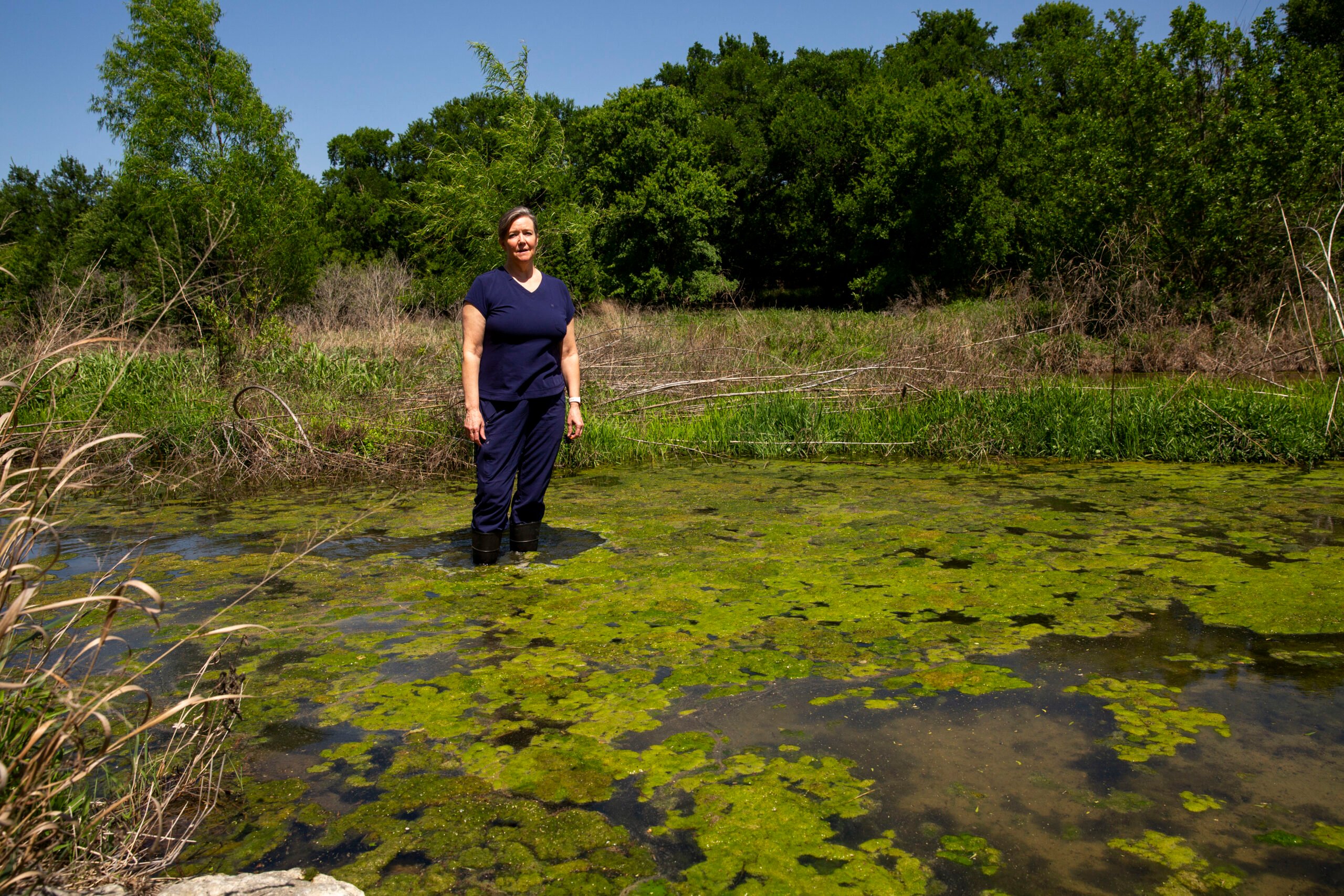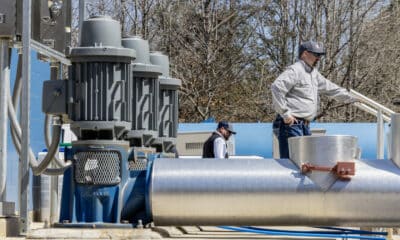News from the South - Texas News Feed
Possible Cornyn, Paxton primary matchup preoccupies GOP
As Texas gets redder, John Cornyn could face toughest primary season of his career
“As Texas gets redder, John Cornyn could face toughest primary season of his career” was first published by The Texas Tribune, a nonprofit, nonpartisan media organization that informs Texans — and engages with them — about public policy, politics, government and statewide issues.
Sign up for The Brief, The Texas Tribune’s daily newsletter that keeps readers up to speed on the most essential Texas news.
WASHINGTON — Sen. John Cornyn is facing what could be the toughest primary challenge of his career as the state party takes a decidedly rightward turn and his popularity among Republican voters dips from 2020 highs.
It’s a remarkable turn for the four-term senator who — before last year losing his bid for party leader — had never lost an election in his life, served in the highest echelons of the Senate Republican Conference, had an early hand in the Republican takeover of Texas and secured a host of legislative wins directly impacting the state.
Attorney General Ken Paxton has repeatedly hinted that he’s interested in challenging Cornyn in the Republican primary, saying on Fox News he could be making moves soon.
“As far as my plans, right now, I don’t know. I’m just going to serve as attorney general,” Paxton said. “I’m looking potentially at the U.S. Senate. We’ll look at that over the next couple of months.”
Cornyn’s office confirmed last week that he is seeking reelection.
But polling suggests that if Cornyn and Paxton were to have a primary today, Paxton would win. Among Republican-identifying voters, Cornyn has an approval rating of 48% — one of the lowest of state-wide office holders, according to a polling aggregate by the Texas Politics Project at the University of Texas at Austin. Paxton, meanwhile, has an approval rating of 60% among Republican-identifying voters. Texas’ other senator, Ted Cruz, has an approval rating of 78% among Republicans.
If Cornyn were to retire, several members of the U.S. House could also launch a bid. U.S. Reps. Beth Van Duyne of Irving, Wesley Hunt of Houston and Ronny Jackson of Amarillo have all been discussed in Republican circles, though none have publicly vocalized their intentions as Paxton has.
Jackson was Trump’s physician in the White House, and Trump’s endorsement in his first race for Congress in 2020 helped Jackson beat controversy in the primary over allegations of workplace abuse during his time in the White House. Jackson is an impressive fundraiser for a House member in a deeply red seat, raising more than $6 million in the last election cycle. He invested in Spanish-language ads in 2022 to raise his name recognition among voters outside his district. Jackson’s campaign did not respond to a request for comment.
Van Duyne was the first mayor to endorse Trump when she was mayor of Irving, and was the 2024 Texas GOP victory chair, campaigning for Cruz and Trump.
Her campaign didn’t say if she was considering entering the primary. “Beth is focused on delivering President Trump’s America First agenda: secure borders, confronting Mexican cartels, tax relief and lower costs for working families, American energy dominance, and an economy with rising wages,” her campaign said in a statement.
Hunt led much of the Trump campaign’s outreach to Black men in the last election cycle and interviewed to be his Defense secretary late last year. Trump endorsed Hunt in his Congressional races in 2020 and 2022, and Hunt has proven himself a prodigious fundraiser, raising more than $7 million in his first U.S. House race. Hunt was recognized with a primetime speaking slot at the Republican National Convention this year. Hunt’s campaign declined to comment for this story.
But Cornyn is not making any signs of stopping. He has taken on more committee assignments this year — several that will be central to some of the biggest policy priorities of the Trump presidency. He finished 2024 with $4.1 million in cash on hand, according to a source briefed on his fundraising operation, and has been meeting with some of his biggest supporters throughout Texas since the beginning of the year.
When asked if he would still run for reelection shortly after losing the leadership race, Cornyn said, “absolutely.”
Early support set a smooth 2020 path
Cornyn has faced primary challenges from the right before and mobilized his formidable operation to quash them.
He ran against a crowded primary in 2014 with seven Republicans hoping to unseat him, including then-U.S. Rep. Steve Stockman. The Friendswood Republican at the time cited Cornyn’s distaste for Sen. Ted Cruz’s filibuster against government funding legislation that would fund the Affordable Care Act. Cornyn, who was Senate minority whip at the time, said the tactic was not effective, though he shared Cruz’s antipathy for the health care law.
Cornyn obliterated the opposition. He won his primary with 62% of the vote. Stockman secured just over 17%. Cornyn raised over $11 million in that race. Stockman raised just over $115,000.
In 2020, Cornyn faced a potential challenge from U.S. Rep. Pat Fallon, R-Sherman, who was then a state senator. Fallon said at the time that Cornyn “has had 18 years. Some of the things you agree with until you check under the hood” as he launched an exploratory committee into a Senate run.
But Cornyn was armed not only with his bountiful funds but also endorsements from across the Republican ideological spectrum. Cruz endorsed Cornyn in December 2018 — two years early and less than a month after securing his own victory against Democratic U.S. Rep. Beto O’Rourke. Gov. Greg Abbott, Lt. Gov. Dan Patrick and Trump also endorsed Cornyn ahead of the 2020 primary.
Fallon eventually decided against running in the primary and ran for the U.S. House that year. Cornyn won reelection handily. Fallon did not respond to a request for comment.
This time, Cornyn has not yet secured the endorsements that helped stave off a primary challenge in 2020. Cruz, whom Cornyn helped with over $500,000 in his own competitive reelection campaign last year, has not endorsed in the Senate primary.
When asked if he had spoken to Cornyn about endorsing him, Cruz said “it’s early to worry about politics in a race two years away. John Cornyn and I have worked together very closely for the last 13 years, and we will continue to work together very closely.”
“We’ll have plenty of time to have those conversations,” Cruz continued when asked why he was not endorsing early like in 2018. He had the same answer when asked about a potential Paxton run.
Cruz and Paxton operate in overlapping orbits, with senior staff for Cruz previously serving in Paxton’s operation. Cruz also defended Paxton through his impeachment and enjoys considerably higher popularity among the conservative base than Cornyn.
Cruz notably voted for one of Cornyn’s opponents, the right-wing Sen. Rick Scott of Florida, in the first round of voting in the majority leader race. He would not say if he voted for Cornyn or Sen. John Thune of South Dakota in the second round. Thune won the majority leader race with 29 out of 53 votes.
Abbott’s and Patrick’s campaigns did not respond when asked if they would endorse Cornyn.
Trump’s pick
The endorsement that could count the most is Trump’s. His endorsement has catapulted multiple Republicans through crowded primaries in Texas.
The president has so far made no indication whom he would support. With the primary more than a year away, there’s plenty of time to audition for the presidential blessing.
Few have done more for Trump’s cause — and done so more brazenly — than Paxton. He led a lawsuit challenging the results of the 2020 election and repeatedly sued the Biden administration to stop its legislative agenda. Trump gave the attorney general a special shout out during his inauguration this year. Trump even floated his name for U.S. attorney general last year.
Cornyn, meanwhile, has appeared averse toward Trump in the past. He told reporters in May 2023 that Trump’s “time has passed him by,” suggesting that Trump didn’t have enough appeal in a general election to win. He also expressed concern in a June interview with CBS Texas about Trump’s federal indictment on keeping classified documents in his private residence, saying Trump had “created a circumstance for himself, which is, I think, very serious.”
Cornyn eventually endorsed Trump after he won the New Hampshire primary.
Since Trump won back the presidency, Cornyn has not given Trump any reason to criticize him. He has steadfastly supported all of Trump’s nominees, even his most controversial ones. He voted to advance Tulsi Gabbard, the former Democratic congresswoman from Hawaii, to serve as Trump’s director of national intelligence, despite misgivings even among Republicans about her past comments supporting Russian President Vladimir Putin and ousted Syrian dictator Bashar al-Assad.
Cornyn has also joined Abbott in calling for the federal government to reimburse Texas for Operation Lone Star and is a founding member of the DOGE Caucus, aligning himself with the cost-cutting mission spearheaded by Elon Musk.
Despite his electoral doubts, Cornyn’s support for the president within the chamber has been consistent through the years. He was Senate majority whip during the first years of Trump’s presidency, herding his conference to support the president’s agenda on tax cuts and judicial nominations — including the controversial appointment of Supreme Court Justice Brett Kavanaugh. Cornyn voted more than 92% of the time with Trump’s agenda during his first presidency, and he voted for every Trump appointee in both the Executive and Judiciary at the time.
That hasn’t spared him from Trump’s criticisms, particularly over his work on the Bipartisan Safer Communities Act, a gun safety bill passed following the Robb Elementary shooting in Uvalde. The bill was the first gun safety bill signed into law in decades and invested heavily in community safety measures and limited the ability of high-risk individuals to access firearms.
Trump called Cornyn a Republican in name only for his support of the bill, posting on social media at the time: “The deal on ‘Gun Control’ currently being structured and pushed in the Senate by the Radical Left Democrats, with the help of Mitch McConnell, RINO Senator John Cornyn of Texas, and others, will go down in history as the first step in the movement to TAKE YOUR GUNS AWAY. Republicans, be careful what you wish for!!!”
The Cornyn-Paxton feud
Cornyn and Paxton have had a storied distaste for each other. Before his time in the Senate, Cornyn served as the first Republican Texas attorney general in more than a century. He transformed the position from a sleepy government office to a major force in conservative politics.
Cornyn said he was “disturbed” by Paxton’s various legal troubles and that it was an “embarrassment” that they had not been resolved before Paxton’s 2022 primary.
Paxton has accused Cornyn of being a Republican in name only, urging someone to primary him. He rallied the MAGA base to denounce Cornyn’s bid for majority leader, writing on social media: “Republicans deserve better in their next leader and Texans deserve another conservative senator.”
The differences go beyond personality. Paxton said in early 2024 that it was “unbelievable” that Cornyn would vote for $95 billion in military aid for U.S. allies. Foreign military aid emerged as a major fault line between traditional defense Republicans and the far right last year. Cornyn shot back that Paxton’s “criminal defense lawyers are calling to suggest you spend less time pushing Russian propaganda and more time defending long-standing felony charges.”
When Cornyn was eyeing a run for Senate majority leader, Paxton was vocally against the bid, writing on social media that Cornyn was “anti-Trump, anti-gun, and will be focused on his highly competitive primary campaign in 2026.”
Cornyn replied: “Hard to run from prison, Ken.”
This article originally appeared in The Texas Tribune at https://www.texastribune.org/2025/02/11/cornyn-paxton-possible-senate-primary/.
The Texas Tribune is a member-supported, nonpartisan newsroom informing and engaging Texans on state politics and policy. Learn more at texastribune.org.
News from the South - Texas News Feed
Dish Soap: The Versatile Cleaning Hero You Didn’t Know You Needed
SUMMARY: Dish soap is a versatile cleaning tool that goes beyond washing dishes. It can remove hair dye from skin, clean makeup brushes, reduce condensation on windows, stop squeaky doors, and even clear clogged drains. Dish soap works as a gentle insecticide for plants and is effective for cleaning various surfaces. Consumer Reports highlighted top picks, with Dawn Ultra praised for its suds and Gain Ultra Clean for affordability. However, dish soap shouldn’t be used in dishwashers or washing machines as it creates excess suds that can damage appliances. Additionally, excessive use on skin or hair can strip natural oils.

Discover the incredible versatility of dish soap, a kitchen staple that does more than just cut through grease. Consumer Reports unveils how this soapy superhero can tackle a variety of messes around your home, making it the secret weapon hiding in plain sight.
News from the South - Texas News Feed
Mostly cloudy, slight chance of storms west of SA tonight
SUMMARY:
Title: Mostly cloudy, slight chance of storms west of SA tonight.
Summary: Good Monday morning! I’m meteorologist Justin Horn sharing the forecast. Today will be mostly cloudy with temperatures near 90. Although there’s a slight chance of showers tonight due to potential storms from Mexico, it’s unlikely to impact the river parade. Tomorrow should remain quiet, but expect increased rain chances midweek, particularly Wednesday evening with possible strong thunderstorms. A 40% chance of rain is forecast for Wednesday, along with similar chances on Thursday and Friday. Stay weather-aware, especially with ongoing Fiesta events, but no need to cancel plans.

Better chances of rain by midweek.
News from the South - Texas News Feed
In Booming Central Texas, Wastewater Is Polluting Rivers and Streams
Editor’s Note: This article originally appeared at Inside Climate News, a nonprofit, independent news organization that covers climate, energy, and the environment. It is republished with permission. Sign up for their newsletter here.
Margo Denke set out to rally the town when she learned that a Christian youth camp planned to build a wastewater treatment plant and discharge its effluent into the pristine Hill Country creek that ran through her small ranch.
Denke, a 1981 graduate of Harvard Medical School who moved to the Hill Country in 2013, printed fliers, put them in Ziploc bags and tied them to her neighbors’ cattle gates in the tiny community of Tarpley, population 38. A coalition of families pooled resources, hired a lawyer and dug in for a yearslong battle.
Theirs was one of many similar struggles that have unfolded in recent years across Central Texas, where protection of creeks and rivers from treated wastewater discharge often falls to shoestring community groups as an onslaught of population growth and development pushes ever deeper into the countryside.
“All this would have been destroyed,” Denke said in April as she surveyed a spring-fed stretch of Commissioners Creek. “Raising the money to fight this is not easy. But you have to, you can’t let this just slide by.”
Eventually, the camp owner, who did not respond to a request for comment from Inside Climate News, agreed in settlement negotiations not to discharge into the creek. Instead, they would spray their treated effluent over their own property—an increasingly popular means of wastewater disposal. In exchange, the neighbors would drop their opposition to the two-story dam the camp erected for a private lake and waterpark on little Commissioners Creek.
“I’m trying to stay positive about it,” Denke said. “It was a huge win.”
But the battle never ends amid the rapid pace of development in Texas. Several miles downstream, another subdivision developer wants to treat wastewater and discharge it into Hondo Creek. And in a neighboring watershed, another community group recently stopped another Christian youth camp from discharging into the Sabinal River.
Similar stories repeat throughout Central Texas, where two decades of booming population growth have come with a massive increase in domestic wastewater—mostly human sewage. The effluent from wastewater treatment plants appears clean and clear, but it contains high levels of organic nutrients that can cause algae blooms and devastate native aquatic ecosystems when dumped into streams and rivers.

“Unfortunately, society at large has no idea,” said Jeff Back, a staff scientist at Baylor University who has studied nutrient pollution in Texas waterways for 20 years. “Developers want to continue to do their business, but they need to be responsible.”
Now, as the state Legislature meets for its biennial session, advocates for water protection are supporting a bill that would prohibit most new discharges of treated wastewater into the state’s last 21 stretches of pristine rivers and streams, as defined by measured nutrient levels. Filed by state Sen. Sarah Eckhardt, a Democrat from Austin, it’s the latest iteration of a bill that groups have tried repeatedly without success to pass in Texas.
It wouldn’t ban development along pristine streams. It would just require other outlets for treated wastewater beside the natural waterways. Plenty of solutions are available on the market, from systems for onsite re-use to treatment methods that remove the nutrients from wastewater.
“People have to understand that it’s not going to be free,” Back said. “People want to do everything as cheaply as possible.”
The luxury of doing things cheaply might not last forever. As Texas cities begin to outgrow their water supplies and state leaders increasingly recognize shortages looming on the horizon, there may come an end to the days of showering lawns with drinking water while dumping treated effluent into rivers for disposal.
“This effluent should be considered a resource, not a nuisance to get rid of,” said David Venhuizen, a civil engineer in Austin who sells hardware for on-site water reuse.
It could be used to irrigate and fertilize the turf grass of parks, sportsfields, golf courses and private lawns, which make up the bulk of municipal summertime water use in Texas. In existing cities, such reuse has proven prohibitively expensive because plumbing from wastewater treatment plants is expensive to run out to individual customers.
New development, however, could be built to incorporate on-site wastewater reuse, said Venhuizen. His system, buried underground like a septic system, can treat a household’s wastewater, then drip it beneath the lawn. It could also be adapted at neighborhood scale for subdivisions to create a decentralized network of wastewater treatment and local redistribution.
But the breathless pace of suburban sprawl in Texas leaves no time to pause and make systemic changes. Instead, Texas cities run pipelines to distant aquifers to meet the ever-growing needs of new neighborhoods that will use most of their drinking water on lawns while piping away their effluent for treatment and discharge into a creek.
“We’re going to continue to rely on extraction instead of any regenerative kind of water systems,” said Venhuizen, 78, on a rocking chair in his backyard fitted with rainwater collection tanks and covered in native plants. “The madness has to stop.”
Stephanie Morris bought a house on the South Fork San Gabriel River, 27 miles north of Austin, in 2013. She wouldn’t have done it if she knew what the beautiful river would become.
When she and her family moved in, Morris said, the neighbors were already exhausted by a long-running battle with the neighboring city of Liberty Hill over its discharge of treated wastewater into the river about a quarter mile upstream.
Back then, Liberty Hill had about 1,000 residents, and its discharge created relatively minor algae problems in the river. Then its population exploded, like many other small cities of Central Texas. Now almost 15,000 people live in Liberty Hill, most of them relying on the South Fork San Gabriel for their wastewater disposal needs.
“There’s a hell of a lot more people pissing in the pond,” said Morris, a high-risk labor and delivery nurse, as she trudged through the green, mucky river in high rubber boots. “Every year things would get worse as their volume increased.”
All those nutrients, primarily from human waste, have caused the riverbed to choke up entirely with algae at times, extending three to five miles downstream and burying native ecosystems. When the algae dies, it sinks and rots in heaps of black, stinking muck.
Year by year, Morris became increasingly involved, until she spent all of her free time trekking the riverbed and taking photos of the destruction to show to her elected representatives, commissioners of the TCEQ and judges at the administrative law courts in Austin.
As a result, the TCEQ has twice reduced the concentrations of phosphorus that the Liberty Hill plant is permitted to discharge, although its overall volume continues to increase. The river looks better today than it did several years ago, Morris said. But the fight has nearly exhausted her.
“This has cost so much time and money, it’s not even funny,” she said. “Private citizens should not have to be enforcing the environmental standards of the state.”
The story of the South Fork San Gabriel, and the pictures that circulated online, jolted other communities to fight against proposed discharges in their areas, said Annalisa Peace, executive director of the Greater Edwards Aquifer Alliance, a group that helps its member organizations challenge the proposed discharge permits in the 21 counties that overlie the Edwards and Trinity aquifers.
“It’s incumbent upon the citizens and GEAA to raise the money for the legal fees to do all this,” Peace said. “It seems to be that the burden is placed on the average citizen.”
Most new wastewater sources come from new housing subdivisions and the municipal utility districts that are established to serve them, she said. Others are commercial projects, from summer camps to music venues, that plan to treat their own wastewater. Much of the new construction, especially near pristine streams, takes place outside of any city’s jurisdiction so it faces little regulation or oversight.
Previous attempts to pass statewide regulations of discharges into waterways have repeatedly failed, said Peace, who has worked with GEAA for 20 years. Much of the resistance comes from lobbying by major homebuilding companies that are making big money off explosive population growth in Texas.
“It’s the big nationals that we’re really seeing the most intransigence and the most organized opposition from,” she said. “They don’t like regulation.”
The Texas Association of Builders declined to comment on this report.
Peace wishes for a law increasing treatment standards for wastewater discharge into all Texas waterways. But she’ll settle for the current bill, which protects just the remaining pristine segments, and provides exemptions for cities and river authorities.
Outside the Texas Legislature, groups have had more success challenging individual permits. Such was the case on the Upper Sabinal River, where another Christian youth camp, operated by the national nonprofit Young Life, proposed in 2019 to build a wastewater treatment plant that would discharge into the river. Local landowners rallied. They gathered 25,000 signatures on a petition and hired a lawyer to challenge the discharge permits.
Faced with an extensive delay in state administrative courts, Young Life opted to settle instead. Young Life did not respond to a request for comment.
“Once this became a high-profile issue, they were willing to look at alternatives,” said Jeff Braun, a landowner on the upper Sabinal River and a spokesperson for the Bandera Canyonlands Alliance, which fought the permit. “I think it hit a chord with a lot of people that are native Texans because they all love these iconic streams.”
In an announcement of the settlement agreement in August 2021, Young Life said it would reuse most of its wastewater on-site for irrigation rather than discharging into the river. Regulators call this practice “land application,” and it’s growing in popularity.
By banning discharges into pristine streams, the bill in the Legislature would effectively force developers in those areas to use land application for wastewater disposal. Although the practice is less impactful to waterways than direct discharge, it can still do damage.
Mike Clifford, technical director at the Greater Edwards Aquifer Alliance, said that opposition from community groups has already pushed many developers to seek land application permits.
“The problem now is we just have too many of these,” he said. “They’re popping up everywhere.”
The TCEQ has issued 413 active permits for land application of treated wastewater, according to online records, and 2,374 active permits for discharge.
For example, community groups are currently fighting a planned 10,000-seat amphitheater, luxury hotel and condominium complex on 84 acres nestled next to the Barton Creek Habitat Preserve on Barton Creek, a pristine stream, in Austin. The complex would treat its own wastewater with land application permits to spray up to 120,000 gallons per day of treated effluent onto its property.
Over time, Clifford said, the nutrient pollutants would accumulate until a big rainstorm washes them into Barton Creek. About five miles upstream, on Fitzhugh Road, another proposed 5,000-person music venue wants to treat its own wastewater and discharge it into ponds near Barton Creek.
One solution, Clifford said, would be for Texas to require developers to add nutrient removal to their treatment process.
“It’s just about money,” he said. Nutrient removal “can double the cost of a wastewater treatment plant.”
With adequate investment, plenty of solutions exist. Some could even be configured to make money that covers part of their costs. For example, some treatment systems that remove nitrogen and phosphorus from water do it by growing algae, which could be harvested and sold as fertilizer. To avoid the buildup of nutrients where effluent is sprayed onto land, grasses can be harvested and sold as hay. Irrigation of hay for livestock is the largest water demand driving shortages in parts of Texas and the West.
Eventually, water scarcity will compel urban planners to make use of wastewater rather than dumping into rivers, said Brian Zabcik, advocacy director for the Save Barton Creek Association, which has pushed for discharge protections on Texas pristine streams through several successive legislative sessions.
“It’s crazy that we’re using our highest-quality drinking water to water our lawns and flush our toilets,” he said. “It makes a lot more sense to use recycled wastewater for those purposes.”
Texas might soon have to consider systemic changes as its population continues to boom, temperatures continue to rise, a multi-year drought persists and water shortages approach. Already, changes are beginning in small pockets.
Zabcik pointed to West Texas cities of Big Spring and El Paso, national pioneers in the reuse of treated effluent for drinking water. In Austin, a new city government building features on-site wastewater treatment and recycling for non-potable uses. Consumer products exist to do the same at any home, building or neighborhood.
These aren’t radical practices, said Zabcik, who lives on his grandparents’ ranch in Bell County. Conserving water was part of life for previous generations in Texas. For example, Zabcik said, his grandparents grew a garden, but not with their drinking water; they ran in a pipe from their stock tank. The water from their washing machine drained onto the lawn.
Passing protections on pristine streams won’t ban development along those stretches, Zabcik said. It will just require new approaches to wastewater use. Although they remain costly for now, prices may come down as necessity boosts demand for new affordable products.
The timeline will depend on whether Texas finds the political will to implement new wastewater systems in advance, or if it waits for scarcity conditions to force its hand.
“We’ve got to reuse every drop,” Zabcik said. “It’s really stupid to be wasting wastewater.”
The post In Booming Central Texas, Wastewater Is Polluting Rivers and Streams appeared first on www.texasobserver.org
Note: The following A.I. based commentary is not part of the original article, reproduced above, but is offered in the hopes that it will promote greater media literacy and critical thinking, by making any potential bias more visible to the reader –Staff Editor.
Political Bias Rating: Center-Left
The content reflects a strong focus on environmental conservation, community activism, and the impact of development on natural resources. It presents the struggles of local communities in Central Texas against wastewater discharge into pristine rivers, framing these efforts as necessary for protecting the environment. The mention of political figures such as Democrat Sarah Eckhardt and advocacy for regulatory changes indicates a tendency toward policies aimed at environmental protection, often associated with more progressive or center-left positions. The article also critiques the role of developers and industry in resisting regulation, which aligns with a broader environmentalist agenda.
-

 SuperTalk FM6 days ago
SuperTalk FM6 days agoNew Amazon dock operations facility to bring 1,000 jobs to Marshall County
-

 News from the South - Missouri News Feed2 days ago
News from the South - Missouri News Feed2 days agoMissouri lawmakers on the cusp of legalizing housing discrimination
-

 News from the South - Alabama News Feed7 days ago
News from the South - Alabama News Feed7 days agoPrayer Vigil Held for Ronald Dumas Jr., Family Continues to Pray for His Return | April 21, 2025 | N
-

 News from the South - Florida News Feed6 days ago
News from the South - Florida News Feed6 days agoTrump touts manufacturing while undercutting state efforts to help factories
-

 News from the South - Florida News Feed6 days ago
News from the South - Florida News Feed6 days agoFederal report due on Lumbee Tribe of North Carolina’s path to recognition as a tribal nation
-

 Mississippi Today4 days ago
Mississippi Today4 days agoStruggling water, sewer systems impose ‘astronomic’ rate hikes
-

 News from the South - Oklahoma News Feed6 days ago
News from the South - Oklahoma News Feed6 days agoOklahoma Treasurer’s Office Faces Scrutiny Over Use of Signal in Anti-ESG Coordination
-

 Mississippi Today1 day ago
Mississippi Today1 day agoDerrick Simmons: Monday’s Confederate Memorial Day recognition is awful for Mississippians













































